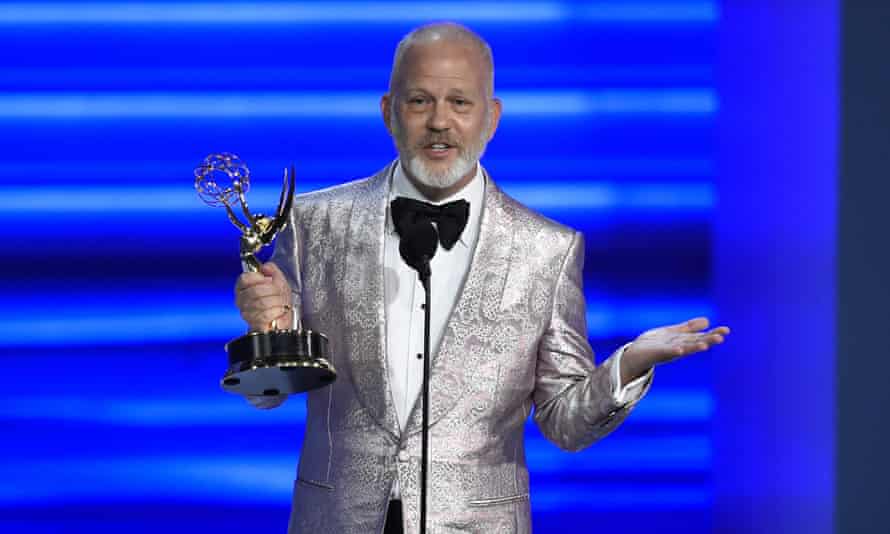Bow down, bow down before the towering chutzpah of Ryan Murphy – who in just four years has made Feud, Hollywood, The Prom, The Boys in the Band, Ratched, two seasons of The Politician, three apiece of American Crime Story and Pose, and four of American Horror Story – for making a show about a talented gay man whose mistake was to spread himself thin.
Yes, Murphy has made his TV show again – this time about the fashion designer Halston (played by Ewan McGregor), whose clothes were everywhere in the 70s and who was himself in with the Studio 54 crowd. Eventually, he fatally diluted his brand by trying to be everything to everyone, signing a deal with JC Penney to mass-market his designs, which put paid to his high-end business.
Just as JC Penney was a bad fit for Halston, Netflix is in many ways a bad fit for Murphy. In seeking to provide content for the platform – as part of a $300m (£210m) megadeal – Murphy has plundered recent history and gay culture for inspiration. The result is a series of shows that are superficially outre, but somehow defanged, like Halloween costumes designed for kids.
Murphy’s shtick, in Halston as in his other Netflix material, is to provide “fabulous” content that may lend itself to bingeing. In line with his trademark style, there are glam costumes; tall, brown-haired, handsome male actors who are up for a bit of objectification; older women in lurid hats; a smattering of bon mots. But crucially, binge-watching seems to rob Murphy’s shows of their singularity and bite: each one appears disposable and undercooked where they seek to be powerfully resonant.

His Netflix work is a far cry, and a noticeable change in tone, from his trashy zenith when he was making TV for FX, which, among other things, saw him enlist Lady Gaga as a bloodthirsty witch of the woods called Scáthach. The new stuff offers a coolly revisionist take on some aspect of gay, or gay-adjacent, culture. It is here that Murphy falters, as high camp is sunk by a surfeit of sincerity.
Halston offers a masterclass in this clash. From McGregor’s mincing to the snazzy fashion montages via Liza Minnelli at Studio 54, the show seems in love with the confected glamour of its subject, while studiously offering a portrait of gay struggle that goes against all that headiness. To his credit, Murphy offers up a tolerable amount of gay sex in Halston. But it is always counterbalanced by a weirdly lecturing bent, which sees Halston’s lover, the hilariously named Victor Hugo, moan to Halston that he wants to be a couple. Really? That feels like a leap.
But then Murphy’s instincts toward insipid liberal progressiveness have been going in this direction since he signed with Netflix – for instance, the preposterous scene in his series Hollywood, in which a character stages a wedding proposal to his closeted boyfriend in the 1940s. Gay marriage is, of course, the ne plus ultra of progress – no matter that gay men couldn’t get a mortgage nor cohabit, let alone be out, at the time.

That incongruous tone was already evident in Pose, where the lives of the Black, queer, transgender queens on show were persistently underscored by a tediously shallow discourse of self-actualisation. Pose seems remarkably modern in its understanding of sex, gender, race and representation, but devoid of period-appropriate grit and detail. That show wasn’t made for Netflix under Murphy’s deal, but it feels significant that on the platform it appears under the Black Lives Matter banner. That deadening sense of content as a vehicle for social justice is what marked Murphy out as such an important creative force – and what is now killing his work. The Prom was another case in point. What started out as a rather pleasingly acidic confection of a film, with witty songs and sassy barbs, ended up drowning in a miasma of follow-your-LGBTQ-dreams. Why must homosexuality mean something! Can’t it just be fun?
The idea of Murphy becoming a purveyor of inspiring stories rubs up uneasily against certain questionable scenes he has created. In Halston, there is something so queasy about the depiction of the designer’s sexual encounters with Black men, often for money. But that objectification is not offset by any effort to dig deeper into the lives of people of colour. When Halston first picks up his Black lover, Ed Austin, the designer crassly compares their experiences of being outsiders. Later, Victor gives Halston a speech about “fucking the shit” out of him, while jerking him off in a stairwell. This is portrayed as erotic powerplay, which frames Victor in much the same way as Halston saw him – ie fetishistically. There are so many moments in his shows that seem to reflect an unthinking privilege: in the world of Murphy, who is rich and white, the struggles of gay people, Black people and women are all roughly equivalent. In Hollywood, he has a half-Filipino man, a Black woman and a Black gay man all winning Oscars in the 40s, to course-correct the injustices of history.
These examples of high school-level identity politics are crass, coarse and in that respect just about the campest element in Murphy’s new work. His earlier shows, for instance Nip/Tuck, showed a devil-may-care taste for the trashy, which has now been all but lost. The hallmark of his creativity, a camp spirit that indulged in a queerness which used to be more shocking, has been caught up with by the changing times. Murphy’s new work is camp, certainly, but in Susan Sontag’s words, “one must distinguish between naive and deliberate Camp. Camp which knows itself to be Camp is usually less satisfying.”

